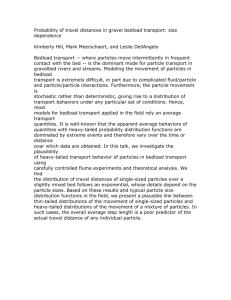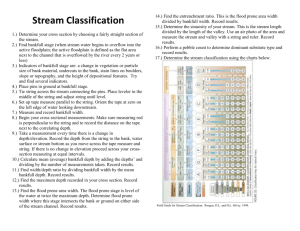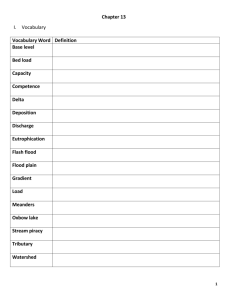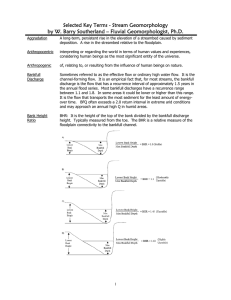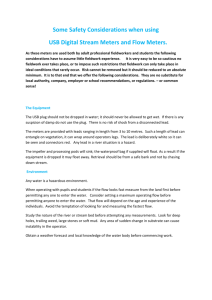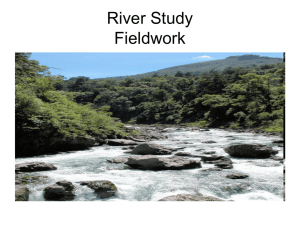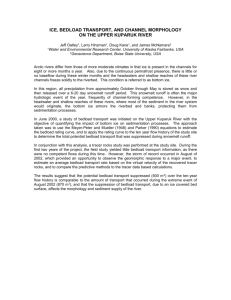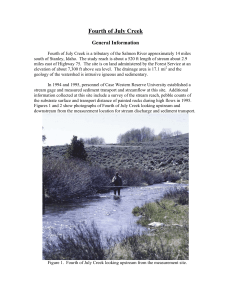Measuring the cross
advertisement
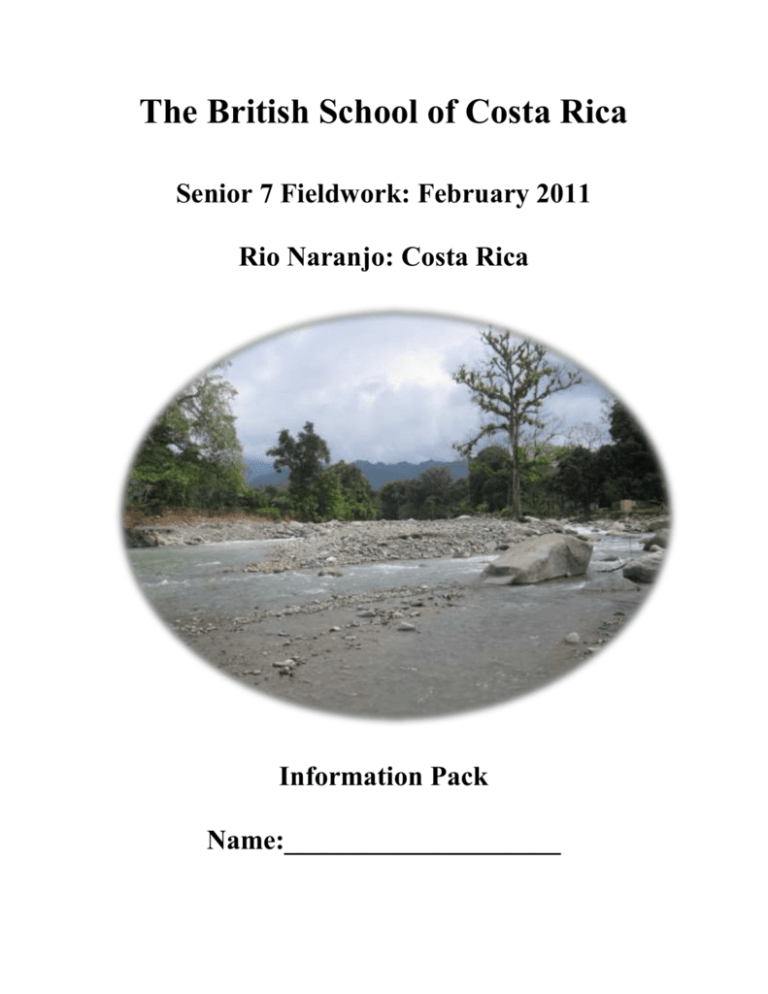
The British School of Costa Rica Senior 7 Fieldwork: February 2011 Rio Naranjo: Costa Rica Information Pack Name:____________________ Geographical studies in: Hydrology and river systems At the end of the field visit you should fully understand and be able to demonstrate your understanding of the following: River transects Transects, use of clinometers, sediment selection, velocity measurements, description, width & depth measurements, calculation of cross sectional area & discharge, recording and reporting of findings Field Sketching: Scale, techniques, annotation and appropriate information for physical and human scenes Globalisation The interconnectedness of the fieldwork venue with local, national and global places and people Methods of analysis: Qualitative methods (to do with feelings and opinions) and quantitative methods (to do with measurable quantities) Questionnaires: Construction, open/closed questions, appropriateness of questions, collation of data and representation of data Tourism: Physical and human attractions, benefits and problems for LEDCs and MEDCs, solutions to problems and sustainability Urban Land Use How different functions cluster together within a settlement, how to determine sphere of influence and how to locate the PLVI (Peak Land Value Intersection) Measuring Flow Velocity At three points along the river, your group must determine average velocity at that point. Since we don’t have fancy flow meters with spinny things on to measure the river’s velocity, we will use the old fashioned orange peel method… 1. Have a think about which of the three sites you expect to have the highest velocity before you begin. Be clear about why you think that. 2. Measure out a distance of 10 metres, and mark it at either end with a ranging rod 3. Throw in a piece of orange peel upstream of your first marker 4. When the peel passes the first marker, begin timing its passage downstream 5. When the peel passes the second marker, stop timing. 6. Write the time down, and repeat 10 times so you can calculate an average later on Measurement number 1 2 3 4 5 6 7 8 9 10 SITE 1 SITE 2 SITE 3 Follow-up tasks (Do 1 & 2 tonight, since you probably won’t have a calculator with you today): 1. After you have completed your measurements, calculate an average for each site and convert it into metres per second 2. Did your results reflect what you initially thought? If so, well done, but if not, why do you think that was so? 3. Have a think about the kinds of external factors and limitations that may affect the accuracy of this survey, and write these down overleaf along with ideas for how the survey method could be improved. Bedload Sampling In this exercise you will examine the relationship between the distance from the source and bedload size, and test the hypotheses: “bedload increases in size with distance from the sea” and “bedload becomes more angular with distance from the source” Take random samples from each site we visit along the river. Collect data on particle size, shape. Make sure you include: What is the main type of particle in your sample? o Clay and silt: < 0.075 mm o Sand (Fine, medium & coarse grained) : 0.075 to 4.75 mm o Gravel: 4.75 to 75 mm o Cobbles: 75mm to 300mm o Boulders: > 300mm The measurement of the particle’s long axis What sort of material is your sample made up of – is it sedimentary rock, igneous rock, organic material etc? Angularity – is your material angular, sub-angular, sub-rounded or rounded? Record your findings in the table provided. How to Measure Cross-Section & Discharge In order to work out the discharge of a river we must first find out a number of key factors… Cross-section: 1. Measure the width of the channel, across the surface of the water. 2. Measure the wetted perimeter, this is the distance down the banks and across the bed – where water touches the land. 3. Take a metre ruler or ranging pole, stand it upright in the water and measure the depth across the stream at intervals of 50cm. Record all your data in a suitable format (like the one on the next page), and then use it to do the follow up work. How to draw a river cross-section: 1. Using graph paper and your field data sheets, decide on a suitable scale. Both axes must be identical in scale. 2. Plot the distance across the stream against depth, just like an ordinary graph. 3. Join the depth points with a flowing line, and shade or colour the land and water. How to calculate the cross-sectional area: 1. Using the cross section you drew earlier… 2. Add up all the squares above the river bed. 3. What if a square is divided by the bed-line? If it is more than half above the bed-line, include it. If it is more than half below the bed-line, ignore it. 4. Work out what each square is worth in area and add together. Another (less accurate) method of calculating cross-sectional area is to multiply the average width of the river by its average depth. Use this as a quick method of calculation, or as a check for the more accurate method above. How to calculate the discharge: The discharge is the amount of water flowing in the stream at a particular moment. To work this out, you’ll need to know… 1. The cross-sectional area 2. The average speed 3. This formula: Discharge = cross-sectional area * average speed (m/s) The result will be in metres per second (cumecs). River Studies: Recording Sheet Date: _____________________ Location: __________________________ Site No 1 Measuring the cross-section Width of stream: __________ Bankfull Width: ___________ Intervals: ____________ Extra depth at bankfull: _______ Left Bank 1 2 3 4 5 6 7 8 9 10 11 12 13 14 Distance Depth 1 5 Distanc e Depth Comments: 1 6 1 7 1 8 1 9 2 0 2 1 2 2 2 3 2 4 2 5 2 6 2 7 2 8 River Studies: Recording Sheet Date: _____________________ Location: __________________________ Site No 2 Measuring the cross-section Width of stream: ____________ Bankfull Width: __________ Intervals: ________________ Extra depth at bankfull: ________ Left Bank 1 2 3 4 5 6 7 8 9 10 11 12 13 14 Distance Depth 15 16 17 18 19 20 21 22 23 24 25 26 27 28 Distance Depth Comments: River Studies: Recording Sheet Date: _____________________ Location: __________________________ Site No 3 Measuring the cross-section Width of stream: ____________ Bankfull Width: ______________ Intervals: _______________ Extra depth at bankfull: ________ Left Bank 1 2 3 4 5 6 7 8 9 10 11 12 13 14 Distance Depth 15 16 17 18 19 20 21 22 23 24 25 26 27 28 Distance Depth Comments: Measuring velocity: DATA SHEET Site 1 Length of segment: _________________________ (m) Left Bank Mid Stream Right Bank 1 2 3 4 5 Average Site 2 Length of segment: _________________________ (m) Left Bank Mid Stream Right Bank 1 2 3 4 5 Average Site 3 Length of segment: _________________________ (m) Left Bank Mid Stream Right Bank 1 2 3 4 5 Average Average Speed = Distance Average Time (m/s) Bedload sampling: DATA SHEET Site Number 1. Date: ____________ Surveyors:___________________________________________ Observations:________________________________________ _____________________________________________ Particle 1 2 3 4 5 6 7 8 9 10 Details (long axis, angularity, particle type etc) Bedload sampling: DATA SHEET Site Number 2. Date: ____________ Surveyors:___________________________________________ Observations:________________________________________ _____________________________________________ Particle 1 2 3 4 5 6 7 8 9 10 Details (long axis, angularity, particle type etc) Bedload sampling DATA SHEET Site Number 3. Date: ____________ Surveyors:___________________________________________ Observations:________________________________________ _____________________________________________ Particle 1 2 3 4 5 6 7 8 9 10 Details (long axis, angularity, particle type etc) Fieldwork Advice So that we can all enjoy this fieldwork experience, there are a few guidelines and instructions you need to be aware of: Listen carefully to all instructions, and follow them too! Stay with your group at all times – never wander off alone. Put all litter in a bin, or in your pocket/bag. Some of the fieldwork tasks can become dangerous if there is insufficient consideration for safety: you must be constantly alert and on the look-out for strong currents, slippery rocks and other river hazards. Keep yourself and others out of danger by acting sensibly and responsibly at all times. Try to keep this booklet in good order and safe & dry. It could help in your revision for your IB Geography exam. The focus of this fieldwork visit is educational. You are here to learn some Geography. Any fun that may be encountered is purely coincidental, and the organisers can take no responsibility for any feelings of enjoyment you may experience during the visit.
